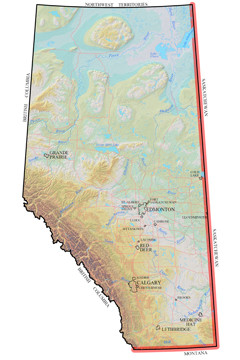Government mail service may be affected by the Canada Post labour disruption. Learn about how critical government mail will be handled.
Overview
Watercraft inspections help protect Alberta’s waters from harmful aquatic invasive species that se great threats to native fisheries, water quality, local economies and industry.
Watercraft include, but are not limited to:
- trailered boats
- non-motorized boats (such as kayaks and canoes)
- inflatables (such as rafts, kayaks and paddleboards)
It's the law
Starting June 1, 2025

To keep invasive species out, anyone transporting watercraft entering Alberta along the east or south borders is required to report to a watercraft inspection station.
If the closest inspection station is closed, the watercraft must inspected within 7 days or before launching into Alberta’s waters.
Everyone travelling with a watercraft, including those entering Alberta from the west or north borders, must still stop for an inspection when passing an open station.
Watercraft owners will get a proof-of-inspection form and a sticker to display after their watercraft is inspected.
Current laws
When highway signage indicates that a watercraft inspection station is open, everyone transporting a watercraft must report to the onsite inspectors to have their boats, trailers and other water-related equipment checked for invasive species such as zebra and quagga mussels, and plants.
Bypassing an inspection station when highway signage indicates that a watercraft inspection station is open while transporting a watercraft is a violation of the Fisheries (Alberta) Act and can result in a $4,200 fine.
All watercrafts must also have their drain plugs pulled while being transported on Alberta highways. Failure to pull the plug may result in a $600 fine.
Large highway road signage with flashing lights indicates when the station is open. Everyone transporting a watercraft must stop for an inspection when the station is open.
Fines
In 2024, fines under the Fisheries (Alberta) Act increased:
- from $324 to $4,200 for failing to stop with a watercraft at an open inspection station
- from $180 to $600 for failing to remove a drain plug when transporting a watercraft on a roadway
Watercraft inspection station locations
We operate watercraft inspection stations across Alberta during the open water season.
Most watercraft inspection stations are located along major highways near port of entry border crossings or at Alberta government vehicle inspection station weigh scales. Roving watercraft inspection stations may also be set up at additional sites in Alberta.
All inspection stations have closed as of October 31, 2025, but watercraft owners entering the province can book an inspection in Lethbridge, Calgary or Edmonton by calling the AIS hotline: 1-855-336-BOAT (2628).
- Download the map of watercraft inspection stations and times from the 2025 season.
Inspection process
Contact
Connect with the Aquatic Invasive Species Hotline if you have questions about the Fisheries (Alberta) Act legislation changes, watercraft inspections or aquatic invasive species:
Phone: 1-855-336-BOAT (2628)
Email: [email protected]